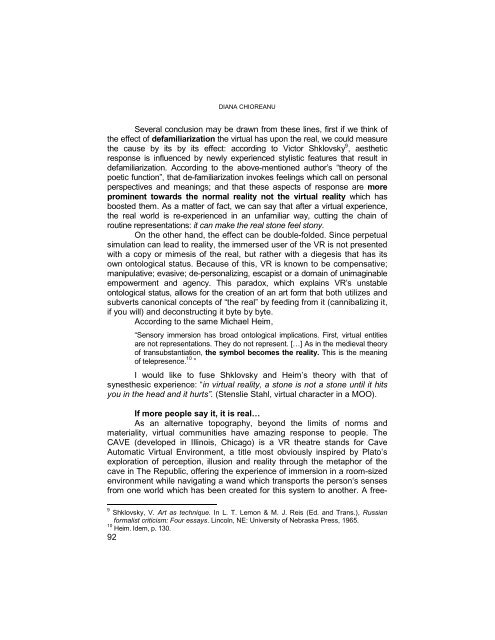studia universitatis babeÅ â bolyai dramatica teatru, film, media 2
studia universitatis babeÅ â bolyai dramatica teatru, film, media 2
studia universitatis babeÅ â bolyai dramatica teatru, film, media 2
You also want an ePaper? Increase the reach of your titles
YUMPU automatically turns print PDFs into web optimized ePapers that Google loves.
DIANA CHIOREANU<br />
Several conclusion may be drawn from these lines, first if we think of<br />
the effect of defamiliarization the virtual has upon the real, we could measure<br />
the cause by its by its effect: according to Victor Shklovsky 9 , aesthetic<br />
response is influenced by newly experienced stylistic features that result in<br />
defamiliarization. According to the above-mentioned author’s “theory of the<br />
poetic function”, that de-familiarization invokes feelings which call on personal<br />
perspectives and meanings; and that these aspects of response are more<br />
prominent towards the normal reality not the virtual reality which has<br />
boosted them. As a matter of fact, we can say that after a virtual experience,<br />
the real world is re-experienced in an unfamiliar way, cutting the chain of<br />
routine representations: it can make the real stone feel stony.<br />
On the other hand, the effect can be double-folded. Since perpetual<br />
simulation can lead to reality, the immersed user of the VR is not presented<br />
with a copy or mimesis of the real, but rather with a diegesis that has its<br />
own ontological status. Because of this, VR is known to be compensative;<br />
manipulative; evasive; de-personalizing, escapist or a domain of unimaginable<br />
empowerment and agency. This paradox, which explains VR’s unstable<br />
ontological status, allows for the creation of an art form that both utilizes and<br />
subverts canonical concepts of “the real” by feeding from it (cannibalizing it,<br />
if you will) and deconstructing it byte by byte.<br />
According to the same Michael Heim,<br />
“Sensory immersion has broad ontological implications. First, virtual entities<br />
are not representations. They do not represent. […] As in the medieval theory<br />
of transubstantiation, the symbol becomes the reality. This is the meaning<br />
of telepresence. 10 ”<br />
I would like to fuse Shklovsky and Heim’s theory with that of<br />
synesthesic experience: “in virtual reality, a stone is not a stone until it hits<br />
you in the head and it hurts”. (Stenslie Stahl, virtual character in a MOO).<br />
If more people say it, it is real…<br />
As an alternative topography, beyond the limits of norms and<br />
materiality, virtual communities have amazing response to people. The<br />
CAVE (developed in Illinois, Chicago) is a VR theatre stands for Cave<br />
Automatic Virtual Environment, a title most obviously inspired by Plato’s<br />
exploration of perception, illusion and reality through the metaphor of the<br />
cave in The Republic, offering the experience of immersion in a room-sized<br />
environment while navigating a wand which transports the person‘s senses<br />
from one world which has been created for this system to another. A free-<br />
9 Shklovsky, V. Art as technique. In L. T. Lemon & M. J. Reis (Ed. and Trans.), Russian<br />
formalist criticism: Four essays. Lincoln, NE: University of Nebraska Press, 1965.<br />
10 Heim. Idem, p. 130.<br />
92

















